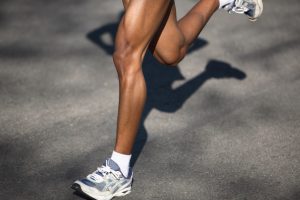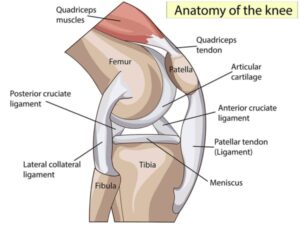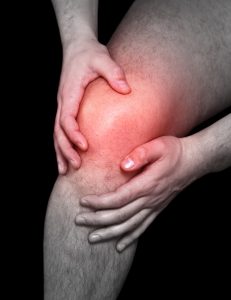Shockwave therapy for patellar tendinopathy is a useful complement to the strengthening program often provided by your physiotherapist. We have used strength training and specifically eccentric strength exercises for lower limb tendinopathies successfully for many years. But improvement can take a long time and pain can prevent a straight forward recovery with a loading program. Scientific evidence indicates shockwave therapy as a useful adjunct to current treatments.
What is patellar tendinopathy?
Patellar tendinopathy is a common overuse injury that typically affects active individuals who play sports or activities that involve a lot of jumping (e.g. volleyball, basketball, dancing) leading to the nickname “jumper’s knee”. However, it can also affect runners and players of any sports that involve quick changes of direction such as football, hockey and rugby.

The patellar tendon is located on the front of the knee just under the patella (knee cap). Often referred to as the patellar ligament as it has two bony attachments. It extends from the bottom edge of the patella (the pole of the patellar) and connects on to the shin bone at a bony landmark called the tibial tuberosity. Pathology and symptoms usually occurs at its origin on the patella (knee cap) but it can be experienced lower onto the tibia.

What causes patellar tendinopathy?
There are many other factors that can contribute to developing patellar tendinopathy some that cannot be changed including genetics, age and your anatomy, and others that are more modifiable such as training load, muscle strength and flexibility.
Tendinopathy at any site in the body has some common contributory factors but some of the more commonly identified risk factors are below. For some people they may have a combination of multiple factors but the most common single factor is training overload.
- A high number of weekly training sessions and/or a rapid increase in training volume or intensity.
- Reduced quadriceps and hamstring flexibility and/or strength.
- Sport specialisation – single sport athletes had a four times greater risk of developing patellar tendinopathy in compared to multisport athletes in one study.
- Movement patterns such as stiff legs when landing.
- Altered foot and ankle mechanics.
Many of these factors can be altered with education, modification of training load and physiotherapy including a strengthening program.
Is shockwave therapy for patellar tendinopathy effective?
A review of the literature shows that shockwave is a safe and effective treatment for patellar tendinopathy, particularly in those for whom other non-operative treatments have failed, as well as those who are looking to avoid invasive intervention i.e.surgery (Schmitz et al., 2015, Mani-Babu et al., 2015, Moyer et al., 2018, Korakis et al., 2018).
A study by Furia et al. 2006 found a significant improvement in the reported pain levels of patients receiving shockwave. At 1 month 50% and at 3 months 75% improvement in pain levels. Maffulli et al (2018) also found similar improvements following a course of shockwave treatment. All measures of pain, function and satisfaction with treatment were significantly improved at the 1, 3 and 12 month stages.
With shockwave being a non-invasive treatment, it avoids the risks of having a surgical procedure and has consistently been shown to be incredibly safe. So applying it alongside your exercise rehabilitation program we can help modify pain and therefore progress your rehabilitation plan.
The use of shockwave therapy for patellar tendinopathy is well supported by our local knee orthopaedic specialists. NICE – National Institute for Health and Care Excellence (NICE). provides national guidance and advice to improve health and social care. It provides evidence based recommendations to guide best practice within healthcare. It indicates shockwave therapy to be safe and effective at treating a number of chronic tendinopathies similar to patellar tendinopathy.
What does shockwave therapy involve?
We usually recommend at least 3-4 sessions at roughly weekly intervals. This is based on the latest research and evidence-based recommendations. Sometimes patients require more than 3-4 sessions if their problem is more chronic. This is dependent on your response to the initial course of treatment and whether additional sessions are likely to further help your recovery.
How long does it take to recover from patella tendinopathy?
A difficult question. Some may self resolve but recovery can take anything from a few weeks to 18 months. No two tendon issues are the same but with shockwave therapy it is certainly not unusual to feel an immediate change in your symptoms, within the treatment period. But more importantly therapy can continue to improve tissue healing over many weeks. Most frequently you will experience a gradual decline in your symptoms over the coming week and months.
You can receive Shockwave Therapy at our Edinburgh South Physiotherapy Clinic.
Contact us to find out more.
References



